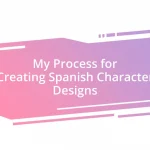Key takeaways:
- Player-driven content enhances gaming experiences by empowering players to shape their narratives, fostering emotional connections and community collaboration.
- Key types of player-driven content include customizable character development, user-generated quests, and mods, each contributing to a more immersive and personalized gameplay.
- Future trends may involve AI integration for personalized content creation, real-time player-driven events, and cross-platform collaborations, enhancing engagement and community building in games.

Understanding player-driven content
Player-driven content is all about giving players the tools and freedom to shape their gaming experience. I remember a time in an open-world game where I crafted my own quest, and it felt exhilarating to see my choices impact the narrative and environment. Isn’t it thrilling to think about how our imagination and creativity can directly influence a game world?
What truly fascinates me about player-driven content is its ability to foster community and collaboration. I’ve had moments where collaborating with other players led to unexpected plot twists, creating rich stories we’d never have encountered in a single-player narrative. Have you ever thought about how these shared experiences can deepen our emotional connections to both the game and to each other?
Moreover, player-driven content blurs the line between developer and player. It empowers us to become co-creators rather than mere consumers. I often find myself reflecting on the responsibility that comes with this power; the choices we make can enhance or dilute the experience for others. How do we balance our creative expressions while maintaining a collective harmony?

Importance of player engagement
Player engagement goes far beyond simply pushing buttons; it’s about immersing ourselves in the experience. When I’ve invested time in customizing my character or developing a storyline, there’s a connection that evolves. It’s as if I’ve woven a part of myself into the game, which not only enriches my experience but also keeps me returning for more. I genuinely believe this emotional stake leads to more sustained interest and investment in the gaming world.
- Engages players emotionally, fostering a deeper connection to the game.
- Encourages players to share their experiences, enhancing community interaction.
- Increases retention rates as players feel personally involved in the narrative.
- Stimulates creativity, allowing unique storytelling opportunities among players.
- Creates a sense of ownership over the game, making every victory and defeat feel personal.

Types of player-driven content
Player-driven content can be categorized into several distinct types that enhance our gaming experience. One major type is customizable character development, where players have the freedom to shape their avatars, choosing appearance, abilities, and personal backstories. I vividly remember investing hours in crafting a character that felt like an extension of myself, making every quest feel more meaningful.
Another type is user-generated quests and challenges. Games like “Minecraft” or “Garry’s Mod” allow players to create and share unique missions. In one instance, I crafted a challenging puzzle for friends, and watching their reactions as they navigated my creation was a delight. It’s a powerful reminder of how our ingenuity can not only entertain but also bring players together in collaborative fun.
Lastly, there are mods (modifications), which can fundamentally alter or enhance gameplay. I’ve dived deep into modified versions of my favorite games, where everything from graphics to storylines was transformed by other players’ imaginations. This kind of player-driven content can breathe fresh life into a game, keeping the community thriving and engaged long after its initial release.
| Type of Player-Driven Content | Description |
|---|---|
| Character Customization | Players can create and modify their avatars to reflect personal style and narrative. |
| User-Generated Quests | Players design and share unique challenges, enhancing cooperative gameplay. |
| Mods | Community-created alterations that change graphics, mechanics, or storylines for a fresh experience. |

Benefits of player-driven content
When I think about the benefits of player-driven content, I can’t help but feel that it transforms gaming into a collaborative art form. This customization allows players to express their individuality, making the game world feel more like a canvas for creativity. Have you ever spent hours perfecting a character that feels uniquely yours? Those moments really deepen your emotional connection to the game.
Another remarkable benefit I’ve noticed is how this type of content fosters a sense of community. Players often share their creations, whether that’s a character build or a new quest design. One time, I shared a challenging mission I crafted with friends, and their excitement as they navigated my challenges created such a vibrant discussion. It’s fascinating how a simple interaction can lead to a shared experience that brings players closer together.
Finally, the retention rates for games that incorporate player-driven content speak volumes. There’s something incredibly rewarding about seeing how my decisions impact the game world, making each success or failure feel personal. I’ve often found myself returning to games just to experience the ripple effects of choices I made. It’s a captivating cycle where my investment fuels the game’s evolution, keeping my interest alive.

Challenges of implementing player-driven content
Implementing player-driven content comes with unique challenges that can sometimes feel overwhelming. For instance, balancing player creativity with a cohesive game experience is no small feat. I’ve seen game developers grapple with this issue and often wonder, how much freedom is too much? Striking that balance is crucial, as too much chaos can lead to disjointed gameplay that frustrates players rather than engages them.
Another significant challenge is moderating the content generated by players. Allowing gamers to create and share their own quests can be a double-edged sword. I recall a scenario where a popular user-generated quest went viral, yet it was riddled with bugs that disrupted the experience. That situation sparked heated debates in forums, leaving developers scrambling to address the fallout. It’s a stark reminder that while player creativity is invaluable, it requires vigilant oversight to maintain quality and enjoyment.
Lastly, ensuring a diverse range of contributions without stifling individual expression can be tricky. I’ve noticed that sometimes, the most vocal players dominate discussions or content creation, which can marginalize quieter voices. How can developers encourage a more balanced participation? From my experience, implementing feedback mechanisms and rewards for diversity in contributions can help foster an inclusive atmosphere. This way, everyone’s creativity can flourish, leading to a richer gaming experience for all.

Examples of successful player-driven initiatives
One standout example of successful player-driven initiatives is the creation of custom maps in games like “Minecraft.” I remember the first time I ventured into a player-made world filled with intricate designs and imaginative landscapes. It was astonishing to see how fellow players transformed a simple sandbox into a thriving community and an endless source of inspiration. Have you ever had that feeling of awe when exploring someone else’s vision? It’s that unique thrill that deepens my appreciation for the game as a collective experience.
Another fantastic instance is the modding community in games like “Skyrim.” Players have crafted entire storylines, new characters, and even reimagined game mechanics that enhance the original experience. I think back to the first time I tried a popular mod that added a vibrant city filled with quests. It felt like stepping into a brand-new game. Can you imagine the joy of discovering something that players have poured their hearts into? That level of creativity not only extends the game’s lifespan but also fosters a vibrant dialogue between developers and the community.
Additionally, initiatives like the creation of players’ guilds in “World of Warcraft” illustrate how player agency can build enduring in-game relationships. I’ve had the pleasure of joining a guild that became more than just a group of players; we built friendships and shared countless adventures. It’s not just about completing quests anymore; it’s about the bonds we forge. How many other games can claim such organic community building? That sense of belonging is a powerful motivator, making players feel valued and connected, further enhancing the game’s allure.

Future trends in player-driven content
As we look ahead, one intriguing trend in player-driven content is the growing integration of artificial intelligence. Imagine a future where AI tools help players create quests and stories that feel truly personalized. During my gaming sessions, I’ve often thought about how an AI could analyze player preferences and generate content that aligns with individual playstyles. Wouldn’t it be fascinating to see an AI craft a storyline based on how often you choose to engage in combat versus exploration? That kind of dynamic content could lead to a deeper immersion in the game world.
Another notable trend is the rise of live events driven by player input. I remember participating in an online game event where players could vote on certain in-game changes or challenges. The excitement in the community was palpable, and it fostered a sense of ownership. Why not expand this idea further? Engaging players in real-time decisions could create a living game environment that evolves based on our collective experiences. This participatory approach not only enhances engagement but fosters a vibrant community atmosphere where players feel genuinely heard.
Furthermore, we’re also seeing a push towards cross-platform player collaborations. I recently joined a multiplayer gaming session where console and PC players worked together to create unique content. The shared creativity was electrifying! It made me wonder, could this trend pave the way for even more innovative projects? As developers encourage collaboration across different platforms, we may witness an explosion of creativity and shared stories that redefine how we connect and create within games.














